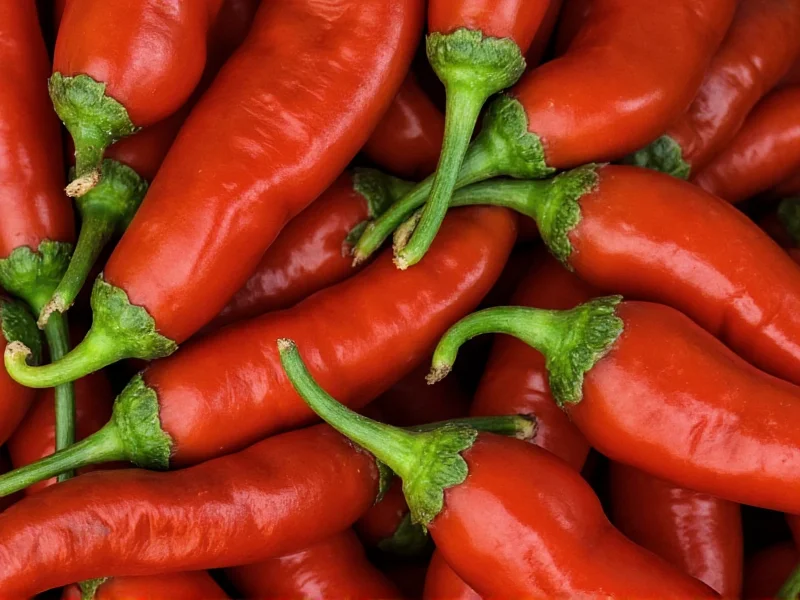When comparing red serranos versus green serranos, understanding the ripening process is key to grasping why heat levels differ. Serrano peppers (Capsicum annuum) begin their life cycle as green peppers and gradually change color as they mature, typically progressing from green to yellow, orange, and finally red. This color transformation represents more than just visual change—it signals significant chemical shifts within the pepper that affect both heat and flavor.
The Science Behind Serrano Pepper Heat
Capsaicinoids, particularly capsaicin, are the compounds responsible for the burning sensation we perceive as "heat" in chili peppers. As serrano peppers ripen from green to red, their capsaicin concentration generally increases. This occurs because:
- The plant continues producing capsaicin as the fruit matures
- Water content decreases slightly in fully ripe peppers, concentrating the capsaicin
- Environmental stressors like temperature fluctuations can boost capsaicin production
However, the heat difference between red and green serranos isn't dramatic. While red serranos tend to be at the higher end of the Scoville scale (12,000-25,000 SHU), green serranos sit at 10,000-23,000 SHU. This slight increase means red serranos are hotter than green on average, but individual peppers can vary significantly based on growing conditions.
Comparing Flavor Profiles of Red and Green Serranos
Beyond heat levels, the ripening process dramatically transforms flavor characteristics. Understanding these differences helps explain why chefs might choose one color over another for specific dishes:
| Characteristic | Green Serranos | Red Serranos |
|---|---|---|
| Heat Level | Moderate to high (10,000-23,000 SHU) | Slightly higher (12,000-25,000 SHU) |
| Flavor Profile | Grassy, vegetal, bright | Sweeter, fruitier, more complex |
| Texture | Firmer, crisper | Softer, slightly thinner walls |
| Best Culinary Uses | Salsas, guacamole, fresh applications | Cooked sauces, stews, roasted dishes |
Factors That Influence Serrano Pepper Heat Levels
While color provides a general indicator of heat, several factors affect the actual spiciness of both red and green serranos:
Environmental Conditions
Peppers grown under stress—such as limited water, higher temperatures, or nutrient deficiencies—typically produce more capsaicin as a defense mechanism. A green serrano from a stressed plant might actually be hotter than a red serrano grown in optimal conditions.
Genetic Variability
Even within the same plant, individual serrano peppers can vary in heat. This natural variation means that when comparing red serranos to green serranos, you might occasionally find a particularly hot green specimen that exceeds a milder red one.
Ripeness Timing
"Green" serranos aren't all picked at the exact same stage of development. Some green serranos may be nearly ready to turn color and thus slightly hotter than very young green specimens. Similarly, red serranos can vary in heat depending on how long they remained on the plant after turning red.
Culinary Applications: When to Use Red vs Green Serranos
The choice between red and green serranos isn't just about heat—it's about how the pepper's complete flavor profile complements your dish:
Green Serranos Shine In:
- Fresh salsas where their bright, grassy notes enhance raw preparations
- Garnishes where visual contrast matters (green against other ingredients)
- Dishes requiring firm texture that holds up in fresh applications
- Traditional Mexican dishes like pico de gallo and guacamole
Red Serranos Excel In:
- Cooked sauces where their fruitier notes deepen during cooking
- Dishes benefiting from subtle sweetness to balance heat
- Recipes where visual appeal of red color enhances presentation
- Complex flavor profiles requiring more nuanced heat
Common Misconceptions About Serrano Pepper Heat
Several myths persist about the relationship between pepper color and heat:
- Myth: All red peppers are significantly hotter than their green counterparts.
Reality: The heat increase is generally modest, and environmental factors often outweigh color as a heat indicator. - Myth: The seeds contain most of the heat.
Reality: While seeds do contain some capsaicin, the highest concentration is actually in the white pith (placenta) that holds the seeds. - Myth: Larger serranos are milder.
Reality: Size doesn't reliably indicate heat level—smaller serranos can be just as hot or hotter than larger ones.
Practical Tips for Working With Serranos
Whether you're using red or green serranos, these tips will help you maximize their potential while managing heat levels:
- Taste before using: Sample a small piece to gauge actual heat level, as advertised ranges don't tell the whole story for individual peppers
- Remove the pith: For milder heat, carefully scrape out the white membrane where capsaicin concentrates
- Balance with dairy: If a dish becomes too spicy, add yogurt, sour cream, or cheese to neutralize capsaicin
- Wear gloves: Always protect your hands when handling hot peppers to avoid transferring capsaicin to sensitive areas
Understanding Serrano Pepper Varieties
While color indicates ripeness stage, serrano peppers also come in different varieties that affect heat and flavor:
- Habanero serranos: A hybrid with habanero characteristics, significantly hotter than standard serranos
- Red devil serranos: Bred for consistent red color and reliable heat levels
- Traditional Mexican serranos: Often smaller and potentially hotter than commercial varieties
When comparing red serranos to green serranos, remember that variety selection can create more significant heat differences than color alone.
Harvesting Serranos: Timing Matters
For gardeners wondering when to pick serranos, understanding the ripening timeline helps optimize both yield and heat:
- Green serranos are typically harvested 50-60 days after flowering
- Red serranos require 80-100 days to fully mature on the plant
- Peppers left to ripen fully to red produce fewer subsequent fruits
- Successive harvesting of green peppers encourages more fruit production
Commercial growers often harvest serranos while still green for consistent supply, while home gardeners might allow some peppers to ripen to red for flavor diversity.











 浙公网安备
33010002000092号
浙公网安备
33010002000092号 浙B2-20120091-4
浙B2-20120091-4